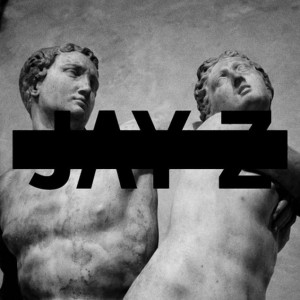Fuse CD Review: Jay-Z’s “Magna Carta Holy Grail” — More Miss Than Hit
Those cynical about the album’s extravagant promotional campaign will be glad to hear that Jay-Z’s latest studio effort is very hit-or-miss.
Jay-Z’s prowess in promotion might just be unmatched in the music industry today. In April, he dropped the single “Open Letter,” which detailed his and Beyoncé’s recent trip to Cuba—an excursion that made international news and garnered a response from President Obama. During the fifth game of the 2013 NBA finals, he aired a commercial that announced he would be releasing his new LP Magna Carta Holy Grail on July 4th via an app made available for free to a million Samsung users. Most audacious of all was his unveiling the album’s cover art alongside the Salisbury Cathedral’s copy of the Magna Carta the day before its release.
Magna Carta Holy Grail has truckloads of hype to live up to—it’s perhaps the most eagerly awaited hip hop release of the year. Those cynical about the extravagant promotional campaign and the #NEWRULES Samsung scheme, which pulled off the capitalistic feat of having the album go platinum before a single copy was sold, will be glad to hear that Jay-Z’s latest studio effort is very hit-or-miss.
The disc begins auspiciously enough with the track “Holy Grail.” Justin Timberlake gets the album’s first word, and he sounds great. The mix on his voice is warm without becoming sickeningly sanitized, as his voice tends to sound on his solo efforts. But Jay doesn’t let Justin upstage him—his vocal flow is as impassioned and breathy as ever. He very much owns the track, which isn’t particularly surprising given that he’s Jay-Z, as charismatic an MC as they come. More surprisingly, JT and Hova covering Nirvana on the bridge goes over amazingly well.
The production on this introductory number is tops, as well. The rhythmic foundation combines a twangy chopped guitar loop with an earnestly serious piano part. This gives way to a skittering kick/snare beat, which is accented by a light keyboard melody. The mix is simultaneously clear and raw, at least by Jay-Z’s standards.
Throughout, the production on this LP is competent, albeit a tad inconsistent stylistically. Unfortunately, rarely do the beats, verses, and hooks accumulate into an impressive track after “Holy Grail.” An interesting texture surfaces now and again, Jay lays down a witty line occasionally, and there are ear-wormy hooks here and there, but never do all these elements come together.
One example of the album’s unevenness is the cut “Somewhereinamerica.” The brass and piano beat is stellar and builds up to a lovely climax featuring orchestral strings. But Jay’s lyrics on this track are throwaway at best and downright asinine at worst. For instance, he channels his inner Lil B with the last line, “Somewhere in America, Miley Cyrus is still twerkin’.” Jay-Z’s tongue is undoubtedly planted firmly in cheek, just as Lil B’s is, but the latter can get away with it because that’s his schtick—listeners have come to expect more from Hova. Still, the distinction for worst line on the track (and possibly the album) goes to “A million sold before the album dropped,” which shamelessly refers to Jay-Z’s Samsung deal.
Braggadociousness is perfectly fine in hip hop—Jay-Z no doubt encourages countless people to dream harder and higher by flaunting his success in his music. He should be proud of how far he’s come: his business and artistic acumen should be used as a source of inspiration for his listeners. The problem is that on Magna Carta Holy Grail his self-congratulatory bragging comes off as wearisome rather than winning.
Watch the Throne, Jay-Z’s 2011 collaboration with Kanye West proves that Jay is more than capable of making his gloating engaging. That album worked because ‘Ye and Hova pushed each other’s braggadociousness to a brazen extreme: admittedly, the project was self-indulgent, narcissistic, even masturbatory. But the album was enjoyable because those qualities are treated with an unembarrassed exuberance. Egos transformed into superegos.
The closest Magna Carta Holy Grail comes to pulling off the same entertaining self-regard as the earlier effort is with the track “Beach is Better,” which clocks in at just under a minute. The production is spectacular, proffering sparkling cloud rap textures over a trap-style beat. Jay-Z’s inflexion and lyrics are also delightfully over-the-top on this track. The song owes part of its appeal to its brevity, which is telling—one of the album’s few truly standout tunes depends on the fact that it is fleeting.
There are moments on Magna Carta Holy Grail that transcend the mediocre. Frank Ocean’s hooks on “Oceans” are lovely enough to make the song memorable. Justin Timberlake makes another appearance later on the album, offering a nicely watery vocal contribution to the cut “Heaven.” Beyoncé pairs well with her spouse on “Part II (On the Run),” which is the disc’s centerpiece. The track “Jay-Z Blue” is a heartfelt rap that the MC wrote for his daughter. His vocal flow and the beat brilliantly speed up in sync towards the backend of the track.
Overall, Magna Carta Holy Grail comes off as competent and likable. It only verges on the intolerable with the track “BBC,” which sticks out like a sore thumb (more like a goiter) because of its amateurish, gruff group vocals. Jay-Z is still a charismatic MC, but the album is mired in weak lyrics, unmemorable hooks, and a production that is too often nondescript—this time around the hype is skin deep.


